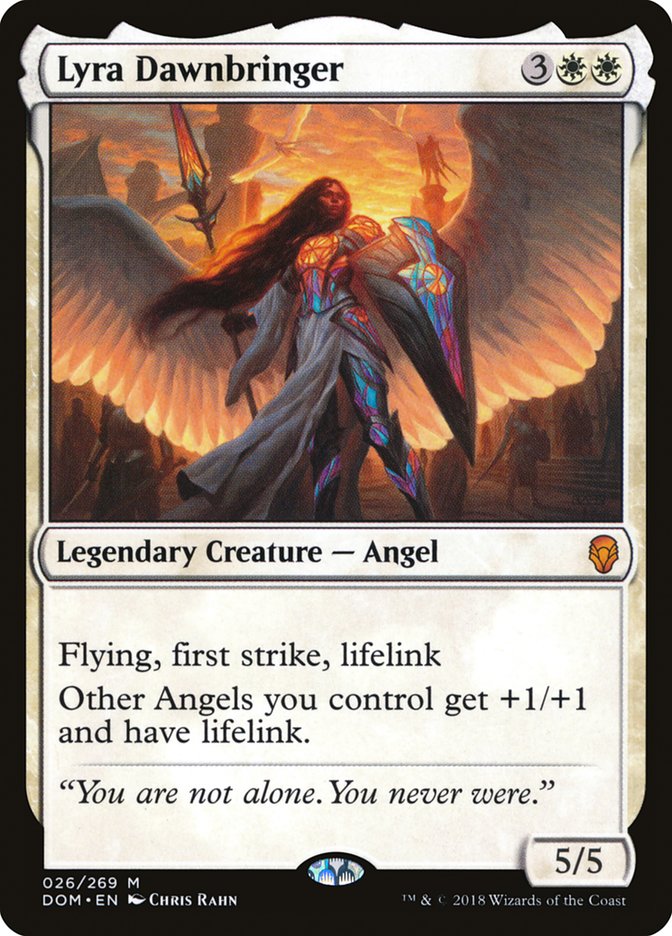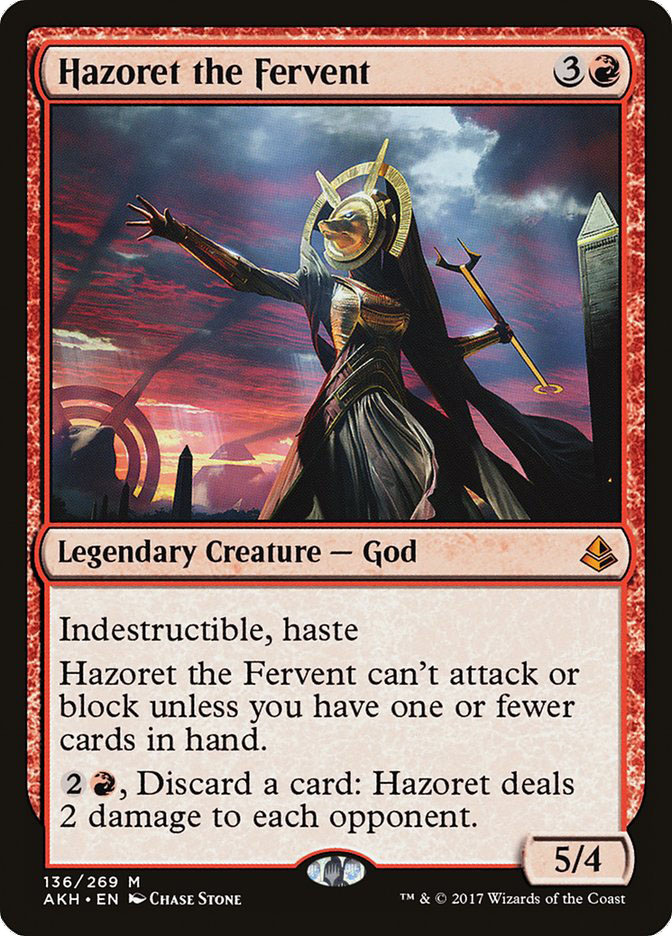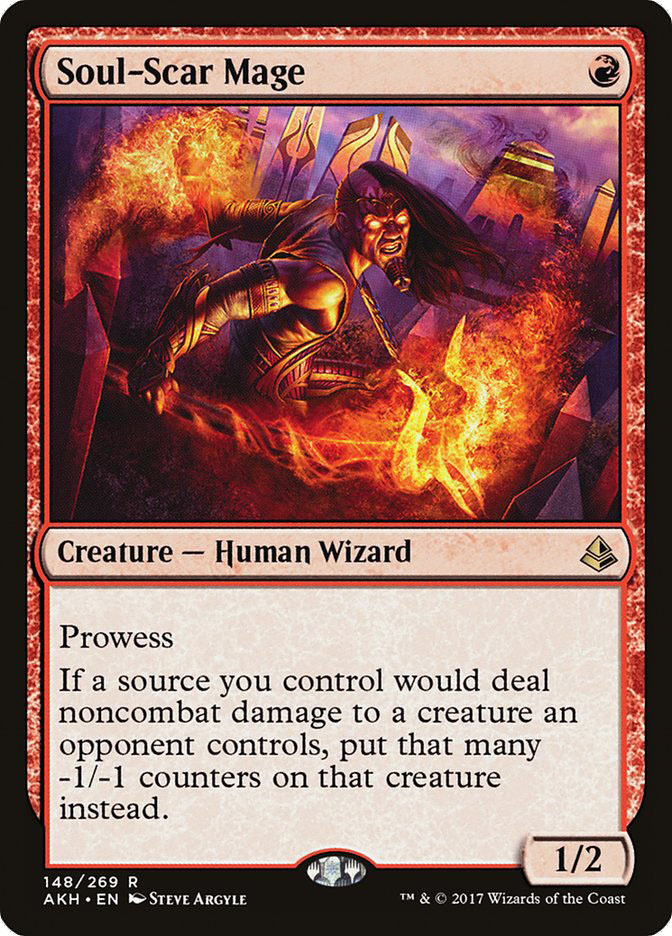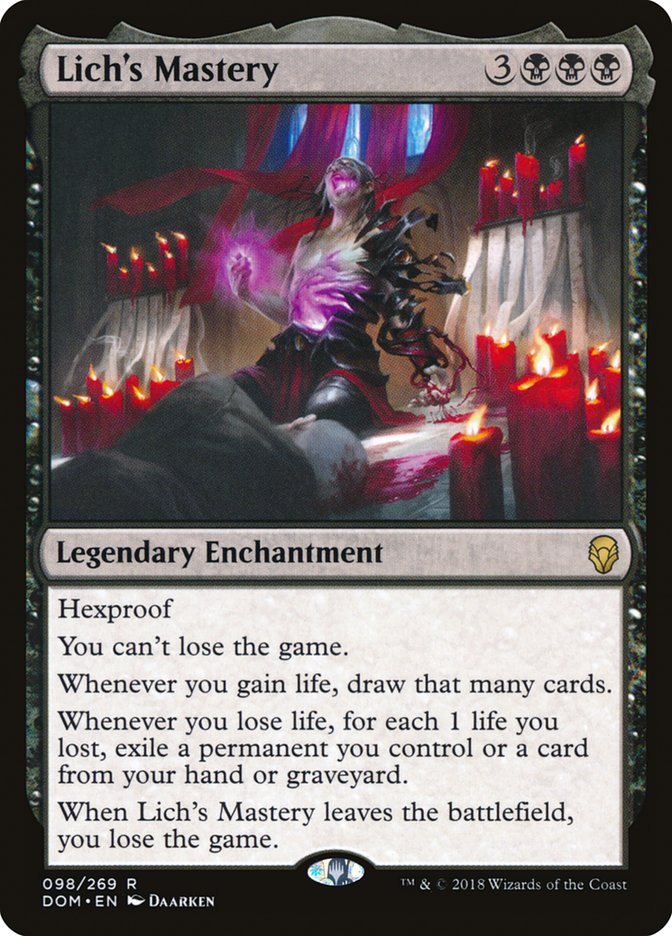This weekend is #SCGBALT
and even though it’s a team event, all eyes are on Standard. Dominaria has already made an impact, with Lyra Dawnbringer
leading the pack. Along with anyone who’s ever played with or against
Baneslayer Angel, I predicted Lyra Dawnbringer would be a major player in
this new Standard format. And while Lyra Dawnbringer mostly saw sideboard
play in U/W Control at #SCGATL,
there was another major Standard event on Magic Online that had her front
and center.
Magic Online tournaments, especially the bigger ones like PTQs or Magic
Online Championship Series (MOCS) qualifiers, feature a lot of quality
players. And since the quality of player is generally higher, the decks
that come out on top usually deserve a second look. And while aggressive
red decks flooded #SCGATL,
the Standard PTQ on Magic Online was a completely different story. You can
find the decklists
here.
Of the Top 8 decks, five of them had white as a major color, all of which
had Lyra Dawnbringer. Five of the Top 8 contained four copies of Llanowar
Elves, including two variations on the Mono-Green Aggro archetype. And
while the decks from #SCGATL
featured a good bit of Mono-Red Aggro Aggro, you have to go all the way
down to eleventh place before you see a single Goblin Chainwhirler.
Considering that my teammate at #SCGATL,
Phil Smith, played Mono-Red Aggro to a 13-2-1 record, this is fairly
surprising to me. I thought Mono-Red Aggro would have a much larger impact
on Standard than what this PTQ is showing. But if I’ve learned anything
from Magic Online over the last decade, it’s that the metagame is about a
week ahead of real life. That leads me to believe that these W/X decks
could be fairly bad matchups for Mono-Red Aggro. Even with four copies of
Goblin Chainwhirler, it might not be enough.
But what if they’re wrong? What if my buddy Phil’s results are more
indicative of the power level of Mono-Red Aggro rather than the result of
live events being further behind on the metagame scale? I watched Phil
dismantle people all weekend. He was our team’s rock. Every time he’d be
cleaning up after a game, we’d look over and ask if he won. His reply,
nearly every time, was “obviously.” So why is the Magic Online metagame so
much different?
My first reaction is that Mono-Red Aggro is quite expensive now. Chandra,
Torch of Defiance, Hazoret the Fervent, and Rekindling Phoenix are all well
above the normal threshold for chase rares. And since many of these new
decks feature a good clip of Dominaria cards, which are cheap
thanks to the huge amount of drafting and sealed deck tournaments happening
right now, there’s a chance that the low cost for these decks is pushing
them to the front of the line. And while price isn’t always a big deal for
Standard decks, Magic Online has a way of leaning toward cheaper options
because people don’t always want to invest $300+ dollars on a digital deck.
Aside from the financial aspect, I think there are a multitude of other
reasons why something like Mono-Red Aggro could be better in a live
tournament than it is on Magic Online. Generally speaking, Magic Online
players are more hostile toward the aggressive red decks. Throughout Magic
Online’s history, the cheapest deck has almost always been Mono-Red Aggro,
and newer players tend to buy the cheapest deck. Hence, Mono-Red Aggro has
always been extremely popular in Standard. And since Mono-Red Aggro was
always extremely popular, people are overly prepared to beat it. That means
more copies of Authority of the Consuls. More copies of cheap, lifelink
creatures. More cheap removal spells. More of everything and anything that
could be good against an aggressive Mono-Red Aggro deck. This isn’t
conjecture. It’s historically accurate.
In live tournaments, people tend to be a little more on the loose side when
a new set comes out. Decks are a bit wilder, untuned, and unrefined. They
are more worried about control decks and midrange strategies and the
boogeyman of the previous format. This time around, I think a lot of people
feared The Scarab God, God-Pharaoh’s Gift, and a host of other powerful
leftovers from the previous Standard format. And to my delight, I don’t
recall playing against a single Standard opponent who played The Scarab God
or God-Pharaoh’s Gift.
There’s a lot of information to be gained here, but there’s also a bit of
information missing. After all, it was a Team Constructed tournament as
opposed to a Standard tournament. I expect most teams just want to go with
the “safer” picks when it comes to deck selection in all three formats.
They want their specialty players to play the decks they’re most
comfortable with. And since Mono-Red Aggro has been a major player in
Standard for quite some time, it’s no surprise that many of our opponents
showed up with the same style of deck that we did. On top of that, only 1/3
of the tournament was Standard, and some of the Standard records could have
been inflated due to their teammates’ success. I just know that our
Standard player carried us hard throughout the tournament, and he was
playing Mono-Red Aggro, which leads me to believe that Mono-Red Aggro is
one of the best decks in the format, if not the best deck.
Creatures (25)
- 4 Bomat Courier
- 2 Kari Zev, Skyship Raider
- 4 Hazoret the Fervent
- 3 Ahn-Crop Crasher
- 4 Soul-Scar Mage
- 4 Earthshaker Khenra
- 4 Goblin Chainwhirler
Planeswalkers (2)
Lands (1)
Spells (32)
- 23 Mountain
- 4 Shock
- 2 Lightning Strike
- 3 Abrade

Phil and I both worked on this deck for a week, though in the end I trusted
his instincts with all the final card choices. Of note, his choice to main
deck Chandra was on-point. It was stellar in all the pre-sideboard games,
acting as a way to deal with larger creatures or generate extra card
advantage/damage when he’d start to fall behind. When you’re ahead, Chandra
is a nearly unbeatable card. And when you’re behind, you can still use it
as a removal spell that they have to attack next turn or risk losing to the
overwhelming advantage it can gain.
I wanted to play a third Kari Zev, Skyship Raider because it’s the best
two-drop you can ask for. The downside of being legendary pushed Phil away
from playing the third copy, instead opting for another Ahn-Crop Crasher to
have more ways to keep the opponent from blocking. And since Phil wanted to
trim on the removal a little bit, the third Ahn-Crop Crasher made sense.
Goblin Chainwhirler is a fantastic addition to this archetype. I know I’m
probably beating a dead horse here but having such a powerful threat that
acts as an answer to problematic stuff is amazing. I can’t imagine how bad
cards like Earthshaker Khenra would be if we didn’t have Goblin
Chainwhirler to clean up all those tiny token blockers.
Goblin Chainwhirler does it all! A 3/3 body with first strike for three
mana is already a decent investment. But when you can clear out a ton of
small bodies that threaten to block and trade with your early creatures,
the three-mana investment looks paltry. This card is pushed on power level.
The only downside to Goblin Chainwhirler, which I’ve talked about before,
is that you can’t afford to play too many Deserts. Colorless lands keeping
you from curving out is a bit annoying when you really need to clear some
blockers on the third turn. And if the trend of Standard being free of both
The Scarab God and God-Pharaoh’s Gift continues, it may be correct to stop
playing Scavenger Grounds altogether.
Soul-Scar Mage has gone up in popularity in these Mono-Red Aggro decks,
thanks to Goblin Chainwhirler, but the synergy doesn’t stop there. After
all, Soul-Scar Mage works with every type of damage that isn’t combat
damage, threatening to shrink big baddies from the opponent, or kill
creatures that couldn’t otherwise be killed with normal damage. And while
Fanatical Firebrand was making a push right before Dominaria, I
think it’s safe to say that Soul-Scar Mage is back for good.
Multiple times throughout the tournament, I watched as Phil used Chandra
and Glorybringer to kill an opposing Hazoret. all because of a little
one-drop creature. And while Soul-Scar Mage doesn’t deal that much damage,
the threat of prowess is often just as powerful as the ability itself.
Attacking with Soul-Scar Mage and another creature or two makes blocking
insanely difficult for the opponent. A single Shock or Lightning Strike
pumps your Soul-Scar Mage while also shrinking your opponent’s blocker.
It’s gross to think about, let alone play against.
One thing red decks tend to have trouble beating is large creatures. Burn
spells usually can’t take down a creature with five or six toughness, so
they stick to the battlefield and you must find a way through them.
Soul-Scar Mage helps alleviate this problem by making them worse as
blockers, shrinking them mid-combat. This can be especially useful against
a deck featuring Lyra Dawnbringer, since the large body with lifelink and
first strike can keep you off lethal damage for quite some time.
The Sideboard
The biggest problem I have with the Mono-Red Aggro deck is how to
sideboard. I think the common plan is to sideboard out a lot of your
smaller creatures in preparation for your opponent having a lot more cheap
removal. In their stead, you have larger threats like Glorybringer, as well
as more removal if the matchup calls for it.
But when do you implement this plan? Are there matchups where going bigger
is a mistake? And if you’re always supposed to go bigger, why don’t you
start big and stay big instead of starting small and getting bigger after
sideboard? After all, Glorybringer seems to come in against virtually every
opponent. It can’t be that bad of a main deck card, right?
Well, the answer probably lies somewhere in between. Glorybringer is a fine
main deck card, as we saw during the entirety of Temur Energy Standard. But
things change. Decks gain cards, new strategies emerge, and in some
instances the format gets much more hostile toward what you’re trying to
do. It’s important to take all that into consideration during deckbuilding,
sideboarding, and gameplay. Always be prepared for the worst while hoping
for the best.
As of right now, it seems like the format is shifting away from Mono-Red
Aggro in favor of white-based strategies. That means more people will be
playing four copies of Fumigate in the coming weeks. Since these G/W
Midrange and History of Benalia decks don’t have a great way to protect
themselves from Fumigate, I expect U/W Control to become better over time.
But I don’t even know if Fumigate is specifically good in U/W Control, or
if U/W Control is just the current best home for Fumigate. We’ve seen B/W
Tokens play four copies of Fumigate in the past, but where else could the
card fit? What other archetypes could take control of the format on the
back of a five-mana sweeper effect?
Planeswalkers (2)
Lands (22)
Spells (36)

Things of Note
-
Lich’s Mastery is a very dangerous card. If your opponent has a
single Scavenger Grounds or other way to exile your graveyard,
every damage is going to force you to lose a permanent or discard a
card. In some matchups, I wouldn’t even bother casting it and would
probably side it out entirely. -
Lich’s Mastery is also your most powerful spell. When combined with
Fumigate, it can clear the battlefield and draw you a ton of cards.
And if you’re low on life, casting Lich’s Mastery might just equate
to “gain ten life” or so, depending on how many cards are in your
graveyard. -
Read Lich’s Mastery, like, ten times. I’ve read it five or six
times now just to make sure I know exactly what it does, and every
now and then a little part surprises me. Mostly, the “exile a card
from a zone” is confusing, because it seems like you can only exile
from your hand or a permanent, but the tacked on “or your
graveyard” is not emphasized, even though it is the most valuable
part of the card. -
Fumigate is going to be stellar in the coming weeks thanks to G/W
Midrange being a major factor, as well as all the Sram’s Expertise
decks. But be sure to try to maximize the value you gain from it.
Use your spot removal early to buy yourself time so you don’t have
to always blow your Fumigate on the fifth turn. -
This deck is not very good against control. Even with Duress in the
main deck, you still have a ton of cards that are virtually dead
draws because they have so few creatures. Though it’s important to
note that cards like Ixalan’s Binding can be pretty good against
their permanents, like Torrential Gearhulk or Teferi, Hero of
Dominaria. -
Against decks like Mono-Red Aggro, you want to save your Ixalan’s
Binding for their really tough (and usually hasty) threats. Chandra
and Hazoret can be troublesome, but Ixalan’s Binding is a way for
you to contain them early, so you can freely tap out for Lich’s
Mastery without giving too much away. -
Splashing a color is probably correct. This two-color version is
just a placeholder until I can get some more work done with the
archetype. My gut tells me that there will be a better version of
this deck in the next month or so using Hour of Promise. We’ve
already seen a few different variations on Hour of Promise decks,
but I would like to see it used to the fullest extent. The card is
insanely powerful, after all, and I want to try to get some into
virtually every midrange strategy I can get my hands on. The
toughest part will be finding out how to build the manabase. -
Experiment! This is a very rough draft, and I don’t even know what
to try next. Cards like Cast Out could end up being better than
Ixalan’s Binding, and I don’t even know if I want eight total
four-mana cards that do the same type of thing. Maybe just four
copies of Vraska’s Contempt is enough? I do like the idea of
Ixalan’s Binding with Lich’s Mastery, though. Having a way to keep
your opponent from casting a second (or third) copy of Hazoret is a
big deal when every life point means another card from your hand or
another permanent leaving the battlefield.
In closing, I just want to say that this Standard format is looking like a
ton of fun. While there are certainly powerful cards in virtually every
deck, none of them are “unbeatable.” In fact, most of the larger threats
from the Standard PTQ on Magic Online just feature a bunch of creatures
that die to one big sweeper. Will this mean Fumigate goes up in value?
Obviously, I’m leaning toward a “yes.”
This weekend is #SCGBALT,
where the SCG Tour will be running another Team Constructed Open. But this
time, my teammate will be none other than Cedric Phillips. As I join him in
the booth to do commentary, I want to say thank you to StarCityGames.com
and everyone involved with the SCG Tour for giving me this opportunity.
I’ve been wanting to move into a commentary position for some time now, and
I’m excited at the prospect of being on camera because you all want me on camera, not because Cedric hurt his foot or Cedric’s
allergies are acting up or Cedric is sick or Cedric missed his flight
because he left for the airport about thirty minutes before the scheduled
departure [CEDitor’s Note: My pain is your gain, Todd!]
While I have done commentary before, I have never been scheduled to do
commentary before. And I can’t wait to show y’all what I can do. Just don’t
expect me to get through an entire broadcast without saying “Roll Tide” a
half-dozen times or so.







